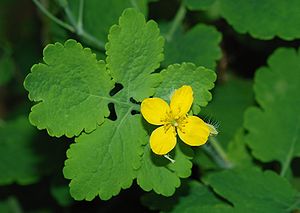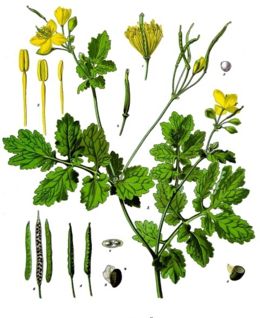- Interestingly the Chinese view on this equates to damp heat encumbering the liver and the gallbladder .
- ---Medicinal Action and Uses---Alterative, Anti-inflammatory, Antifungal properties, Antiviral properties, Antimicrobial activity, Antitumor, Candida albicans, Choleretic – increase bile flow, diuretic, dyspepsia, Hepatoprotective – liver protection, peptic ulcers, purgative and Streptococcus. It is used in jaundice, eczema, scrofulous diseases, etc.
[Chelidonium majus]
Boneset Eupatorium perfoliatum is close to Greater Celandine. Boneset is used to treat Colds, Flu, Arthritis.
Celandine (Greater Celandine): Celandine is traditionally used by herbalists for warts, ringworm and corns; Russia, where it is said to have proved effective in cases of cancer; It is still used in Suffolk as a fomentation for toothache. It is used in jaundice, eczema, scrofulous diseases, etc.
—Botanical name— Chelidonium majus
Warning: The whole plant is toxic, containing a range of alkaloids, such as Chelerythrine; it may also cause contact dermatitis, particularly the latex. Use in moderation and for limited time periods.
—Chinese Botanical name—
Interestingly the Chinese view on this equates to damp heat encumbering the liver and the gallbladder . #
This is a clear statement from the book: “Herbal Medicine – The Natural way to Get Well and Stay Well” by – Dian Dincin Buchman, PhD. Copyright 1979, 1996; ISBN: 0-517-14767-x; Page 9 – 14
Greater Celandine gas a small, brilliant yellow blossom, and the stem exudes a vivid yellow juice when cut or bruised. In Eastern Europe
a tincture of this herb is made from the entire plant and is considered a virtual panacea. The Eastern Europe people use eight to ten drops of tincture steeped in brandy or ninety-proof spirit – or eight to ten drops of the fresh expressed juice – three times a day to overcome sluggish liver, for neuralgia of the face, head and shoulder. It is also useful when there is a thick urine, or clay-like stools and constipation. The juice of the living plant is also a great wound remedy to allay pain (great Celandine is a member of the poppy family) and is an old and effective wart remedy.
Celandine was an admired medicinal plant during the Middle Ages, mostly used to cure eye diseases, for throat cleansing, treatment of ulcers and skin eczema as well as against colic and jaundice. Wood recommends its use for gallstones and migraines, headaches and general pains in the face and head.
Botanical.com always has great information.
—Part Used—The whole herb, collected in the wild state, from May to July, when in flower, and dried. Likewise, the fresh juice.
—Constituents—The alkaloids Chelidonine and Chelerythrin, the latter narcotic and poisonous, also the two nearly allied alkaloids, Homochelidonine A, and Homocheli donine B. In addition, Protopine and Sanguinarine, and a body named Chelidoxanthin, a neutral bitter principle.
—Medicinal Action and Uses—Alterative, Anti-inflammatory, Antifungal properties, Antiviral properties, Antimicrobial activity, Antitumor, Candida albicans, Choleretic – increase bile flow, diuretic, dyspepsia, Hepatoprotective – liver protection, peptic ulcers, purgative and Streptococcus. It is used in jaundice, eczema, scrofulous diseases, etc. #
The infusion of 1 OZ. of the dried herb to a pint of boiling water being taken in wineglassful doses. The infusion is a cordial and greatly promotes perspiration. The addition of a few aniseeds in making a decoction of the herb in wine has been held to increase its efficacy in removing obstructions of the liver and gall. A fluid extract is also prepared, the dose being 1/2 to 1 drachm. Eight to 10 drops of the tincture made from the whole herb, or of the fresh juice, given as a dose three times a day in sweetened water, is considered excellent for overcoming torpid conditions of the liver. In the treatment of the worst forms of scurvy it has been given with benefit.
Greater celandine acts as a mild sedative, relaxing the muscles of the bronchial tubes, intestines, and other organs. A strongly bitter remedy, balmony is principally used to treat gallstones and other gallbladder problems. It stimulates bile flow and has a mildly laxative action. It can be taken to relieve nausea, vomiting, and intestinal colic, and to expel worms. It may also be antidepressant. Balmony is a suitable remedy for children.
The orange-colored, acrid juice is commonly used fresh to cure warts, ringworm and corns, but should not be allowed to come into contact with any other part of the skin.
In milk, it is employed as an eye-lotion, to remove the white, opaque spots on the cornea. Mixed with sulphur, it was formerly used to cure the itch.
An ointment made of the roots and lard boiled together, also of the leaves and flowers, has been used with advantage for piles. Celandine is a very popular medicine in Russia, where it is said to have proved effective in cases of cancer. It is still used in Suffolk as a fomentation for toothache.
—Recipe—


—References— A Modern Herbal – https://botanical.com/botanical/mgmh/comindx.html
—References— “Advanced Treatise in Herbology” by – Edward E. Shook, N.D., D.C. Copyright by Wendell W. Whitman 302 E. Winona Avenue, Warsaw, IN 46580.
—References— Business Dictionare.com http://www.businessdictionary.com/definition/anaerobic.html
—References— “Dicitionary.com” http://www.dictionary.com
—References— “From the Shepherd’s Purse” by – Max G. Barlow, Copyright 1990, ISBN 0-9602812-0-7.
—References— Handbook of Medicinal Herbs second edition By James A. Duke with Mary Jo Bogenschutz-Godwin, Judi duCellier, Peggy-Ann K. Duke
—References— “Healing Herbal Teas” A Complete Guide to Making Delicious, Healthful Beverages. By – Brigitte Mars, A.H.G. ISBN – 13: 978-59120-110-6 and ISBN – 10: 1-59120-110-1 Copyright 2006
—References— Henriette’s Herbal Home – https://www.henriettes-herb.com/faqs/index.html
—References— “Herbal Medicine – The Natural way to Get Well and Stay Well” by – Dian Dincin Buchman, PhD, Copyright 1979, 1996, ISBN: 0-517-14767-x, Page 2, 14-17, 31, 121, 139, 145-146, 162, 165, 168, 190, 192, 193, 202, 206, 252
—Reference— Herbs & Natural Supplements An evidence-base guide Volume 2; By Lesley Braun and Marc Cohen.
—Reference— Indian Spring Herbal Encyclopedia by Natalie Awanata Lapahie
—References— Medicine Net.com http://www.medterms.com
—References— Medical Herbalism The Science and practice of herbal medicine by David Hoffman, FNIMH, AHG, Copyright 2003, ISBN – 0-89281-749-6
—References— “Nutritional Herbology” by – Mark Pedersen, Copyright 2008, ISBN – 10: 1-885653-07-7; ISBN – 13: 978-1-885653-07-9
—References— Planetary Herbology by – Michael Tierra, C.A., N.D., Copyright 1988, ISBN – 0-941524-27-2
—References— “Prescription for Nutrition Healing” by – Phyllis A. Balch, CNC, Copyright 2006, ISBN: 1-58333-236-7.
—References— The Encyclopedia of Herbs – A Comprehensive Reference to Herbs of Flavor and Fragrance -By Arthur O. Tucker and Thomas Debaggio.
—References— Encyclopedia of Medicine By Andrew Chevallier FNIMH
—References— The Healing Herbs – The Ultimate Guide to the Curative Power of Nature’s Medicines” by – Michael Castleman; Copyright 1991; ISBN: 0-87857-934-6; Page: 72 – 74
—References— “The Ultimate Healing System – The Illustrated Guide to Muscle Testing & Nutrition” by – Donald Lepore, N.D. Copyright 1985, ISBN: 0-94717-11560-7.
—References— WebMD http://www.webmd.com/default.htm
—References— Wikipedia The Free Encyclopedia.com http://en.wikipedia.org/wiki/Main_Page
Note: Information and statements about the products on this Book and/or PDF file, have not been evaluated by the Food and Drug Administration and are not intended to diagnose, treat, or prevent any disease. You should not use the information contained herein for diagnosing or treating a health problem or disease or prescribing any medication. If you have or suspect that you have a medical problem, promptly contact your health care provider.
Generated on April 29, 2007
Updated on November 12, 2008
Updated on March 24, 2023



